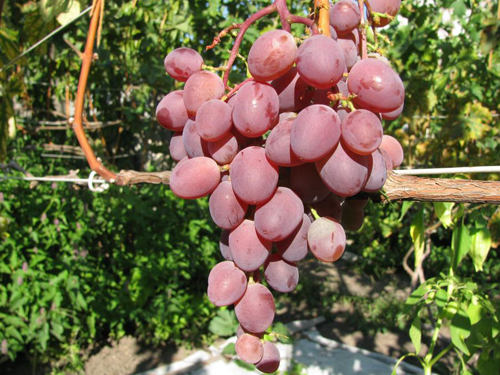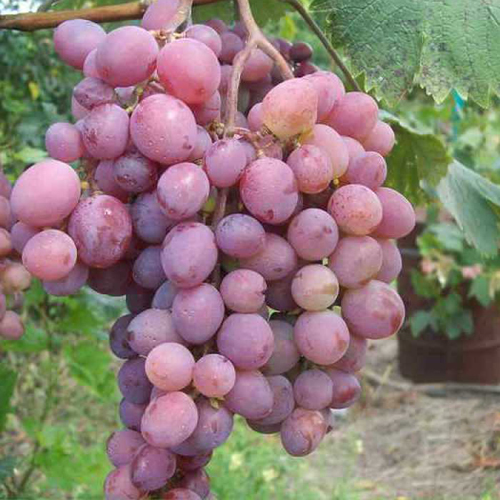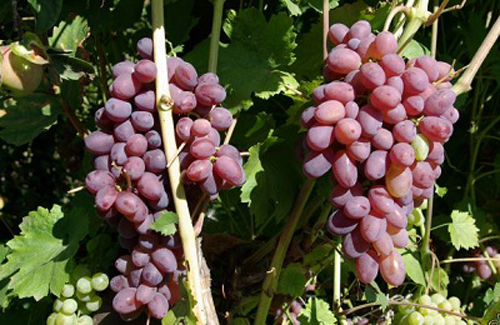Victoria grape variety
While amateur breeders are practicing in breeding more and more new masterpieces that stagger the imagination of winegrowers with the diversity of shapes, colors and sizes of bunches, Russian scientists continue to do their fundamental work. In particular, they continue their efforts to create grapes suitable for cultivation in the harsh Russian climate without shelter, but at the same time yielding a yield comparable in quality to traditional southern varieties.

In this regard, particular importance is attached to the native of the Siberian and Far Eastern taiga - the grape of the species Vítis amurensis (Amur grape). In addition to fantastic winter hardiness, it carries genes for high resistance to such harmful fungal diseases as mildew, oidium and gray rot. All this makes the idea of interspecific hybridization very tempting, in which the resistance to the new variety would be transferred from the Amur ancestor, and the commercial and taste qualities - from the European one. A large number of such experiments have been performed over many decades of painstaking research work, but so far only a few have shown a satisfactory result. One of such representatives of interspecific selection, which managed to come close to the task at hand, is the Victoria hybrid, which has already become known and widespread.
This variety of grapes was obtained by specialists from the All-Russian Research Institute of Viticulture and Winemaking named after V.I. ME AND. Potapenko (Novocherkassk, Rostov region). It was bred as a result of a complex crossing, where a hybrid of European (Vitis vinifera) and Amur (Vítis amurensis) species was used as the mother form, fertilized in turn with the pollen of the American-European grapes Save Villar 12−304. As a result, a new variety was presented to the judgment of researchers, and then winegrowers, which later received the name Victoria, with excellent indicators of winter hardiness, disease resistance, while being quite large-fruited, with berries attractive in appearance, taste and aroma. At the same time, the novelty also had a number of significant disadvantages, such as: weak growth force, difficult pollination, a tendency to strong loosening of the bunch, peeling and cracking of berries.
Agrobiological characteristics
Plants show little vigor, the full bush is only formed by the fourth year after planting. The crown of a young shoot is tender, light green with light, rather intense pubescence. Leaves are medium in size, rounded, five-lobed, with a moderate degree of dissection and a soft reticulate-wrinkled surface of a dark emerald color. The upper lateral notches are deep, closed narrowly elliptical or open slit-like, the lower ones are much shallower in coarseness, open, vaulted with a pointed bottom, or have the shape of an inclined angle. The petiolate notch is broadly vaulted, usually with a flat bottom. The petiole is of medium length, has a reddish tint. The teeth along the edge of the leaf blade are large, triangular, with convex edges and pointed apices. The flowers of this variety have a functionally female flowering type, and therefore require good pollinators in the neighborhood. Annual shoots of Victoria ripen quite early and well, while acquiring a light brown color.

Bunches of grapes are large enough, conical in shape, moderately dense, with insufficient pollination, loose, with an average weight of 500-700 grams or more. The comb is long, green with a reddish base, rather strong. The berries are large, slightly oval, with an average length of 27 mm and a diameter of 22 mm, reddish-raspberry or light maroon color, weighing 6-8 grams. The uniformity of the grapes within the bunch is usually satisfactory, however, in unfavorable flowering years, their peas can be observed. The pulp of Victoria berries has a delicate juicy-fleshy consistency, a pleasant harmonious taste with a clear aroma of nutmeg, which appears when fully ripe. The sugar content of the juice in the variety is quite high - 17-19 grams / 100 ml, the titratable acidity is 5-6 grams / liter. The skin is very thin, intangible, almost transparent in the light. There is a noticeable smoky waxy coating on its surface. There are 1-3 seeds in each berry. Taste assessments of fresh grapes are very positive.
Harvest for universal use. It is good both fresh and for processing into juice, compotes and jam. Homemade preparations from fully ripe berries are distinguished by their elegant color and excellent aroma. Bunches grown in the middle zone of the country with good care and high agricultural technology practically do not differ in taste and appearance from their southern counterparts. The harvest of Victoria is not suitable for long-distance transportation and long-term storage due to the delicate skin of the berries, which is unable to withstand significant mechanical loads and be reliable protection during storage.
The grapes ripen quite early. The growing season from bud break to readiness for harvest is 115-120 days. The sum of active temperatures required for the variety is 2300-2400 ° C, due to which it manages to ripen even at the latitude of the Moscow region. Victoria's frost resistance is quite high (-27 ° C), however, closer to the northern border of its distribution area, this frost resistance, unfortunately, turns out to be insufficient for non-covering cultivation.
The potential productivity of the variety is very significant, and often exceeds the physical capabilities of the plants themselves, which are therefore highly prone to overloading. The percentage of fruiting shoots usually ranges from 70 to 90%. The average number of clusters per developed shoot is 1.1-1.3; for fruitful - 1.4-1.8. From the bush, many growers receive, according to them, up to 20 kilograms of bunches, but only mature, well-developed plants, for which full care is carried out, will "stretch" such a load. Over the years, the yield of Victoria is very unstable, and, in addition to the literacy and hard work of the grower, it depends very much on weather conditions, especially during the flowering period of grape bushes. Overloading has a negative impact on the growth and development of already medium-sized plants, can lead to their strong weakening and even death in winter.

After ripening, it is better not to leave the crop hanging on the bushes for a long time due to the high tendency of grapes to crack, even with a relatively small drop in soil moisture. In addition, wasps are very actively interested in sweet aromatic berries, and the thin skin is not an obstacle for these insects.
Agrotechnical features
Despite all the efforts of scientists who have achieved a high resistance to frost and disease, Victoria has not become the ideal and standard for domestic viticulture. In the process of testing the variety and cultivating it by amateurs in various climatic zones, it showed some gaps in agrobiology, which, in the opinion of growers disillusioned with it, are not fully compensated by the lack of the need to shelter the bushes for the winter and the ease of preventing fungal diseases.
So, for good growth and development, it is advisable to graft grapes on vigorous rootstocks. Reproduction by rooting cuttings in regions free from phylloxera is possible, but the bushes will be very compact.Rooting, by the way, in this variety is relatively easy, as well as fusion with common rootstock forms. In addition, Victoria is demanding on soil fertility and responds very well to regular fertilizing during growth and fruiting.
A variety is usually formed according to non-covering standard schemes, however, in regions where the minimum winter temperatures drop to critical for Victoria -27 ° C, shelter is still necessary. An overly strong heat-insulating layer is not necessary at the same time, it is enough to simply dig the sleeves into the soil or even simply remove the vine from the trellis and lay it on the ground in places with a consistently high snow cover.
The entry of grapes into fruiting usually occurs quite early: already in the second or third year, young bushes strive to throw out the inflorescences, but it is better not to abuse this property in order to give them strength for normal development. Even mature bushes should be loaded very moderately. In the spring, when pruning, only 25-30 eyes are left per bush, shortening the fruit arrows quite strongly (by 6-8 or even 3-5 buds). Weak and sterile shoots are traditionally broken off after the start of the growing season, and extra inflorescences and young clusters must be removed, of which there can be up to three pieces on the shoot, and as a result of thinning, no more than one should remain.
The functionally female type of flower and the associated pollination problems are one of the main drawbacks of the variety. Many winegrowers complain of peas and a very loose bunch, which sometimes does not even dare to call it a bunch, before there are few grapes hanging on it. The situation can be radically corrected by planting a bisexual variety of grapes in the vicinity of Victoria, which coincides with it in terms of flowering. Also, good results are obtained by treating inflorescences with a growth stimulator Gibberellin according to the following scheme: first spraying (dipping) with a solution with a concentration of 3-5 mg / l at the stage of protruding peduncles; the second - during the period of maximum flowering (30 mg / l); the third - in the phase of "small peas" (30mg / l). Such manipulations will not only help prevent loosening of the brushes, but also significantly improve the presentation and taste of the berries, which will acquire an attractive oblong shape, increase in size compared to the standard, and some will even become seedless.
Victoria's other major problem, grape cracking, is more difficult, but also possible. The main recommendation here is careful regulation of the water regime of the soil with the help of irrigation. Even a slight overdrying of the earth should not be allowed, so that as a result of unexpected rains, the soil does not change its moisture sharply, to which this variety reacts very painfully. Against wasps that simply overcome grapes, it is necessary to use special traps or use individual mesh bags for each bunch, which will reliably protect the crop from annoying insects. The fight against mildew, oidium and gray rot in this hybrid is very simple and not laborious. Treatments against fungal diseases are required single and only in the case of the onset of ideal conditions for the development of pathogens.
Thus, Victoria can be considered a controversial, but, nevertheless, noteworthy variety. This is especially true of the "northern" viticulture, where the choice of varieties of this culture is not as great as in the south. It is in non-traditional regions for the cultivation of grapes that this hybrid form finds its most loyal admirers, who, with their work and competent approach, neutralize all its shortcomings, getting excellent yields, which are by right the subject of their pride.








